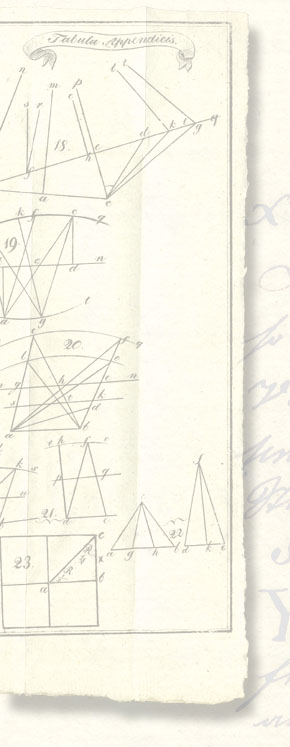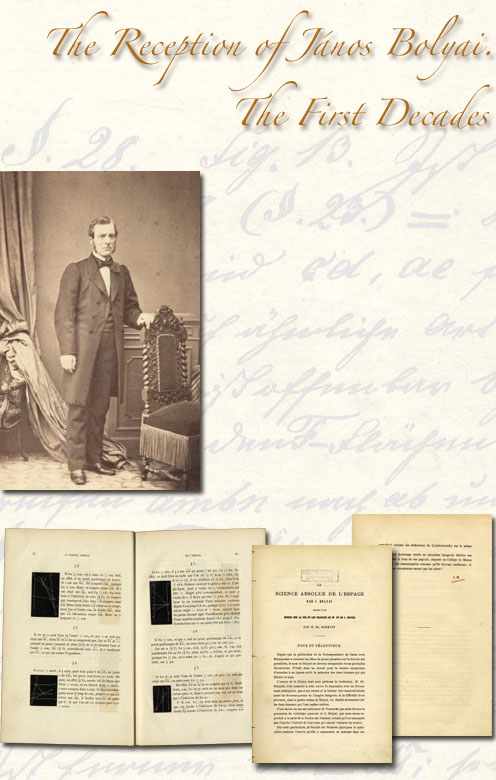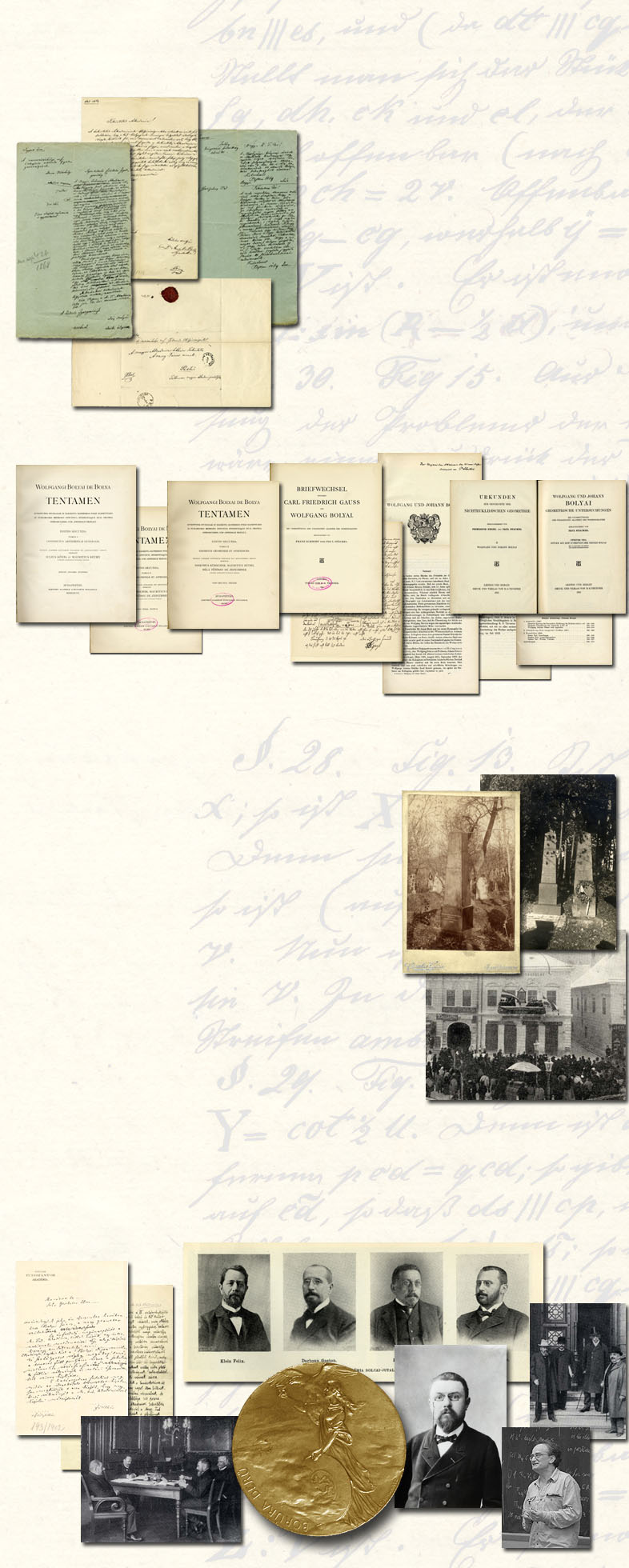





The name of János Bolyai and his unique scholarly achievement became known in the decade following his death. The merit of its propagation is due to the architect Ferenc Schmidt who at the beginning of 1868 published the biographies of Farkas and János Bolyai in the journal Archiv der Mathematik und Physik.
The study and the Appendix by János Bolyai were translated into French by Jules-Guillaume Hoüel who published them in the 5th volume of the Mémoires de la Société des Sciences Physiques et Naturelles de Bordeaux.
The French publication was presented on the assembly of the Hungarian Academy of Sciences on June 15, 1868 by Jenő Hunyady. He proposed to borrow the legacy of the Bolyais from the Calvinist College of Marosvásárhely so that the respective department of the Academy could examine it. Chief secretary János Arany wrote addresed a letter to the College in this sense in June 1868.

The legacy arrived to Budapest in November 1869 and it was deposited in the Library of the Academy under the supervision of chief librarian Pál Hunfalvy.
The 3rd class of the Academy in 1870 established a committee for the examination of the Bolyai manuscripts. Its president was János Ármin Vész, its members Jenő Hunyady, Gyula Kőnig and Ferenc Schmidt. The committee could not find any studies ready for publication. Thus the Academy decided to send back the material to its legal owner, the Calvinist College of Marosvásárhely. The chief secretary of the Academy in his letter of June 2, 1894 informed about the restitution of the Bolyai legacy the directors of the College.
The Academy in 1882 decided to pay homage to the memory of the two great mathematicians by publishing the Tentamen by Farkas Bolyai, also including the Appendix of János Bolyai, in a new, precious edition. The text was edited by Gyula Kőnig and Mór Réthy. Partly because of the difficulties of this work, and partly the debates of copyright with the Bolyai descendants caused that the first volume could be published only in 1897 and the second in 1904.
The rugged life of Farkas Bolyai is presented by his correspondence with Gauss, whose edition was prepared by Ferenc Schmidt and Paul Stäckel. It was published at the same time in a Hungarian and a German edition by the Hungarian Academy of Sciences and the Taubner Publisher of Leipzig.

In 1913 Taubner also published the study of Stäckel which has remained for a long time the only source work on the two Bolyais for the foreign public.
The scholarly achievement of János Bolyai was acknowledged all over the world, nevertheless his tomb remained without a sign and care. Ferenc Schmidt was shown the almost unrecognizable tomb in 1893 by Júlia Szőts, the former servant of János Bolyai. On the initiative of Schmidt the tomb was signed by a memory stone.
In 1911 the authorities of the town decided to bury the two Bolyais in a common tomb. The exhumation of the corpses was done on June 7, 1911, and they were solemnly buried in two metal coffins in the enlarged tomb of Farkas Bolyai in Marosvásárhely. The funeral speech in the name of the Hungarian Academy of Sciences was held by university professor and correspondent member Gyula Farkas.
The 100th anniversary of the birth of János Bolyai was commemorated in his native city Kolozsvár. On January 15, 1903 a festive assembly was held in the Franz Josef University of the city. The inaugural speech in the name of the Hungarian Academy of Sciences was held by the President of the Academy Loránd Eötvös, and chief secretary Kálmán Szily here announced the foundation of the Bolyai Prize of the Hungarian Academy of Sciences.
According to its constitution, the Bolyai Prize was given to the author of the best work in mathematics published in any language and in any place in the previous five years. The prize included 10 thousand golden crowns and a golden medal. It was awarded by a committee of two (a Hungarian and a foreign) members elected by the Hungarian Academy of Sciences.
The golden medal was commissioned by the Academy with Stefan Schwartz, a renowned medal designer born in Hungary and working in Vienna. It was prepared in the state mint of Körmöcbánya (Kremnica).
The Bolyai Prize was awarded for the first time in 1905. The committee, whose members were Jean Gaston Darboux, Felix Klein, Gyula Kőnig and Gusztáv Rados, assigned it to Henri Poincaré.
In 1910 the committee composed by Gyula Kőnig, Gusztáv Rados, Henri Poincaré and Gösta Mittag-Leffler rewarded with the prize the work of the Göttingen university professor David Hilbert.
The First World War prevented the committee in 1915 to nominate candidates in the spirit of the constitution, thus the awarding of the prize was postponed for an undetermined time. At the end of the war both Hungary and the Academy suffered so grave damages that the renewal of the Bolyai Prize was unimaginable. Thus the highest scientific recompensation in the history of the Hungarian Academy of Sciences fell into oblivion for several decades.
After the change of regime in 1989, the chairmanship of the Academy proposed the renewal of the Bolyai Prize in 1991. The Department of Mathematical Sciences in 1994 decided the foundation of the János Bolyai International Mathematical Prize. A great event of Hungarian and international history of science was when, after a break of 90 years, the Bolyai Prize was awarded for the third time, on November 4, 2000 to the Israelian professor Saharon Shelah for his book Cardinal Arithmetic.
In 2005 the prize was judged to the Russian Misha Gromov for his Metric Structures for Riemannian and non-Riemannian Spaces.
The greater part of the manuscript legacy of Farkas and János Bolyai are preserved in the Teleki-Bolyai Library of Marosvásárhely. In 1991, on the initiative of Dr. Ferenc Nagy the Library of the Hungarian Academy of Sciences was offered the possibility of making a complete set of microfilms on the collection. The microfilms were prepared between October 28 and November 24, 1991 by the colleagues of the Microfilm Collection of the Library, László Tőkés, Tiborné Kolthay and Klára Láng.
Literature:
Ács Tibor: A Magyar Tudományos Akadémia nemzetközi Bolyai-díjának megalapítása és százéves kálváriája. Valóság 2002. 5. sz. 50–60. On-line: http://www.valosagonline.hu/index.php?oldal=cikk&cazon=343&lap=0
Sarlóska Ernő: A két Bolyai – az idő sodrában. In Dávid Lajos: A két Bolyai élete és munkássága. Második, bővített kiadás. Bp. 1979. 359–380.
Vekerdi László: A Bolyai-gyűjtemény a Bolyai-kutatásban. In Örökségünk, élő múltunk. Gyűjtemények a Magyar Tudományos Akadémia Könyvtárában. Bp. 2001. 85–114

